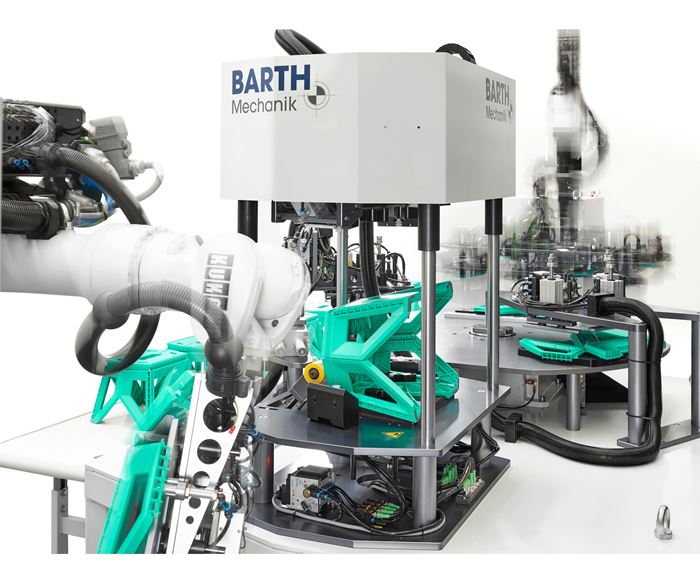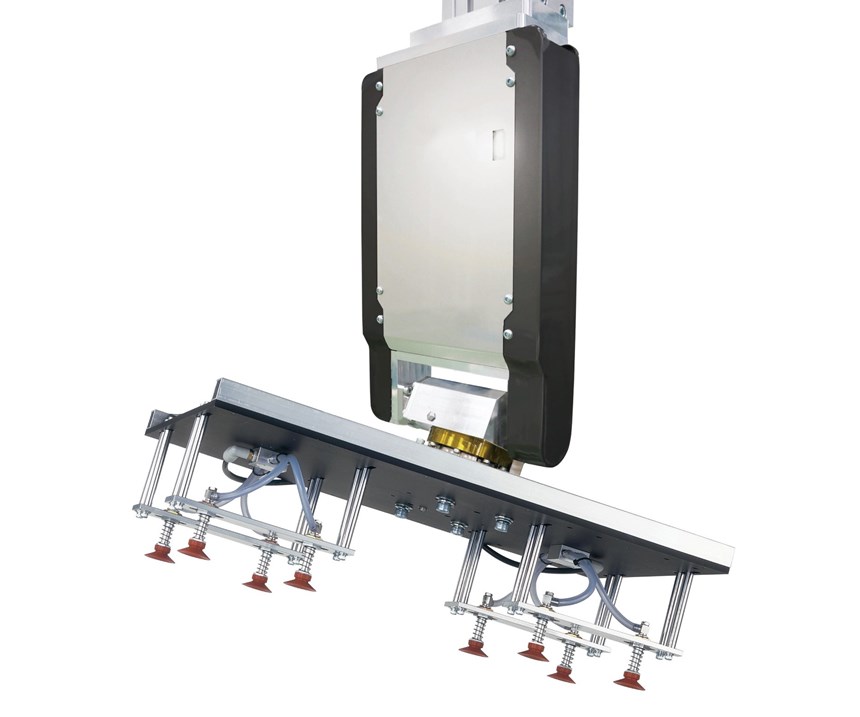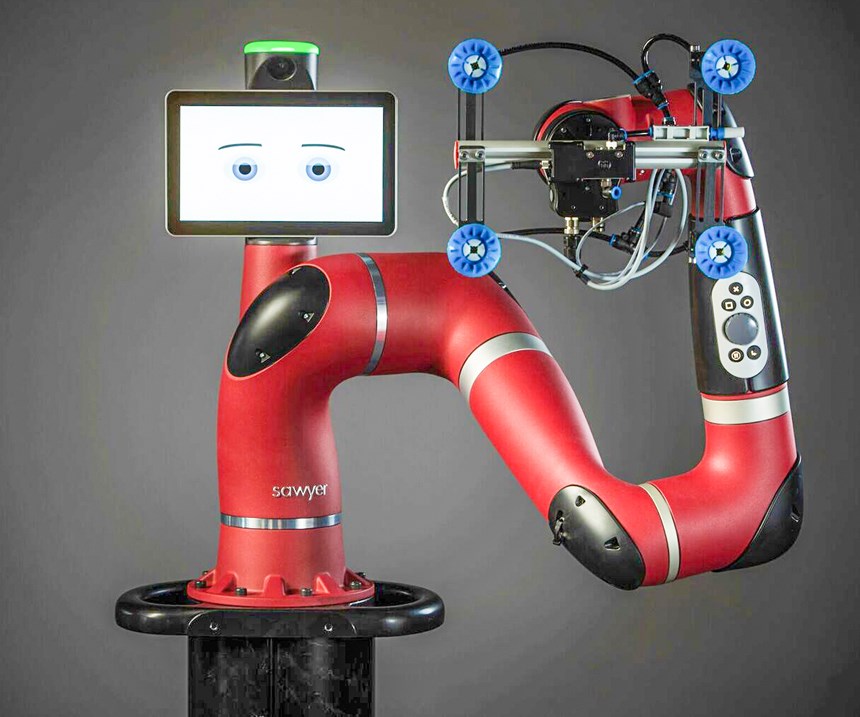More Automation = More Capable Robots
More complex automation tasks require use of six-axis robots, often in combination with linear robots, as well as use of machine vision, SCARA robots, and collaborative types.
Walking around the injection molding exhibits at NPE2018, you will no doubt have noticed that a machine standing on its own molding parts has become less common than elaborate automated cell demonstrations involving multiple upstream and downstream operations. This reflects a gradual transition occurring in molding plants. “We’re seeing more beside-the press automation,” says Chris Parrillo, national sales manager of Yushin America. “More inspection, packaging, assembly, and product serialization using hot stamping, laser engraving, barcode labeling, and RFID chips.”
“We’re seeing more and more being done with takeout robots,” adds Dino Caparco, Yushin’s engineering operations manager. “That means higher speeds and more complex end-of-arm tooling for jobs like insert molding or in-mold labeling combined with part removal.”
One consequence is growing interest in use of machine vision to assist robots. Robot vendors attribute this to molders’ increased emphasis on quality and to the declining cost and increasing miniaturization of vision components. It thus becomes ever more cost-effective to mount cameras on the mold, machine frame, or the robot in order to check for short shots, color, proper degating, proper insert loading, and complete ejection from all cavities. There is also a growing trend to use vision for 100% inspection of parts for dimensional measurement, label orientation, and surface flaws. As many as 16-18 parameters can be checked at once on every part.
Attendees at the last NPE in 2015 will have noted the ability of vision-guided robots to play basketball or miniature golf. In the real world, this translates into ability to locate parts on a conveyor and orient them for stacking and packing. Jim Healy, v.p. of sales and marketing for Sepro America, notes that vision applications today typically still rely on custom solutions; the future will almost certainly bring more plug-and-play simplicity.
In Healy’s view, the trend toward cell automation explains the prevalence of six-axis, articulated robots at this year’s NPE. Notwithstanding the extreme versatility of such robots, most suppliers agree that jointed-arm robots are better applied to downstream functions than to pulling parts out of a mold. As compared with linear robots, they are less attractive in speed, reach, payload capacity, and size of the work envelope that needs guarding—not to mention cost and additional programming effort. On the other hand, they may be advantageous in low-headroom circumstances.
For the most part, however, sources at vendors like Sepro, Yushin, and Wittmann Battenfeld agree that a linear robot with a servo wrist can have five to seven degrees of freedom that compete favorably with jointed-arm types. At NPE, you can see linear robots operating alone, or in pairs—handing off from one to another—or teaming up with jointed-arm robots for downstream operations.
Downstream cell operations are fertile ground for other kinds of robots that may be less familiar to NPE attendees. One is SCARA robots, a type of very fast, extremely compact device typically used in assembly operations to pick and place small, lightweight parts. They typically have three or four axes of freedom and speeds of up to 200 picks/min. They can access extremely confined spaces. A second type of high-speed, light-duty robot is the “spider,” delta, or parallel robot. It has three arms connected to universal joints at the base. It can have three to six degrees of freedom and is capable of up to 300 picks/min. Almost faster than the eye can follow, these robots can reposition multicavity parts for downstream operations after they have been demolded by a linear robot, all within the press cycle, so no buffer area is required.
A newer type of robot that has been gaining attention lately is so-called “collaborative” robots (or “cobots”), which are typically distinguished by modest cost, easy lead-through-teach programmability, and—most important—ability to operate safely around humans without hard guarding in some applications. Typically based on six- or seven-axis, jointed-arm designs, these robots use onboard vision and torque sensors to sense unintended contact with a foreign object and react very quickly to halt further movement. They are generally considered suitable for pick-and-place operations downstream of a molding machine, not for machine tending. As you can see here at the show, a growing number of vendors are coming out with such robots, and mainstream Cartesian robot suppliers are finding cobots to be a valuable addition to their line.
Related Content
What to Look for in High-Speed Automation for Pipette Production
Automation is a must-have for molders of pipettes. Make sure your supplier provides assurances of throughput and output, manpower utilization, floor space consumption and payback period.
Read MoreThree Key Decisions for an Optimal Ejection System
When determining the best ejection option for a tool, molders must consider the ejector’s surface area, location and style.
Read MoreHow to Reduce Sinks in Injection Molding
Modifications to the common core pin can be a simple solution, but don’t expect all resins to behave the same. Gas assist is also worth a try.
Read MoreBack to Basics on Mold Venting (Part 2: Shape, Dimensions, Details)
Here’s how to get the most out of your stationary mold vents.
Read MoreRead Next
Lead the Conversation, Change the Conversation
Coverage of single-use plastics can be both misleading and demoralizing. Here are 10 tips for changing the perception of the plastics industry at your company and in your community.
Read MorePeople 4.0 – How to Get Buy-In from Your Staff for Industry 4.0 Systems
Implementing a production monitoring system as the foundation of a ‘smart factory’ is about integrating people with new technology as much as it is about integrating machines and computers. Here are tips from a company that has gone through the process.
Read MoreMaking the Circular Economy a Reality
Driven by brand owner demands and new worldwide legislation, the entire supply chain is working toward the shift to circularity, with some evidence the circular economy has already begun.
Read More


















